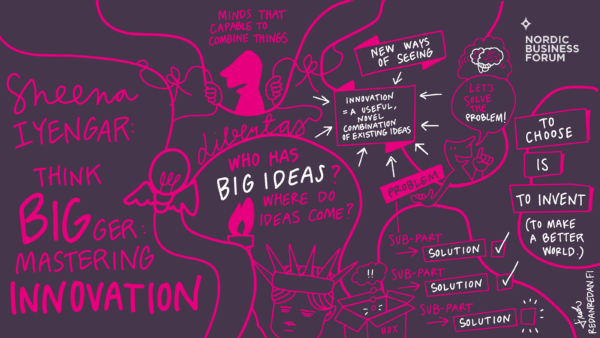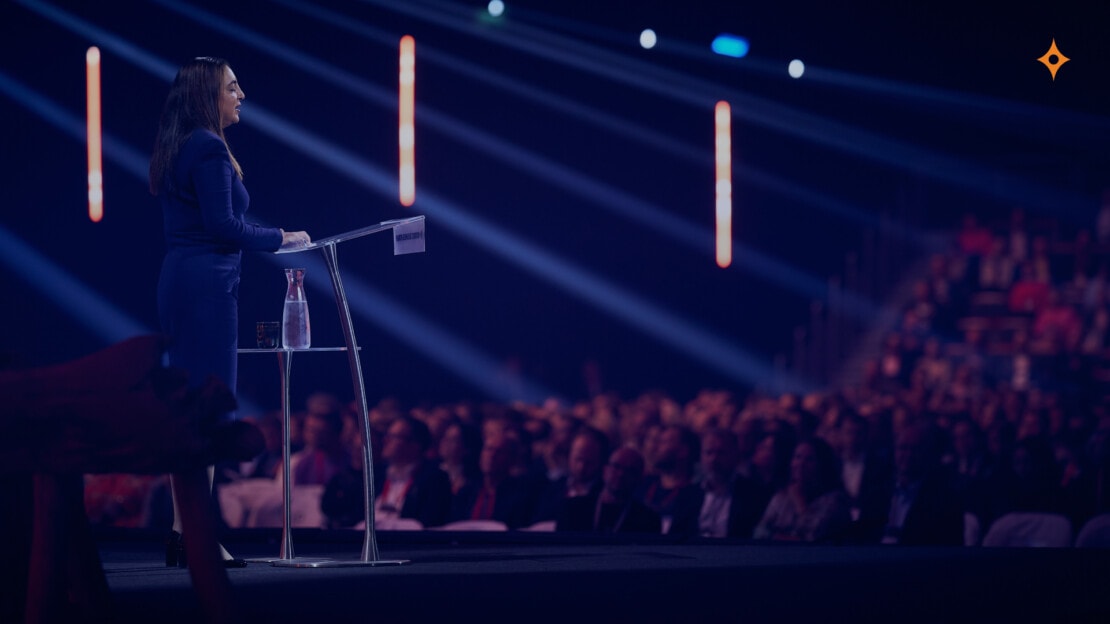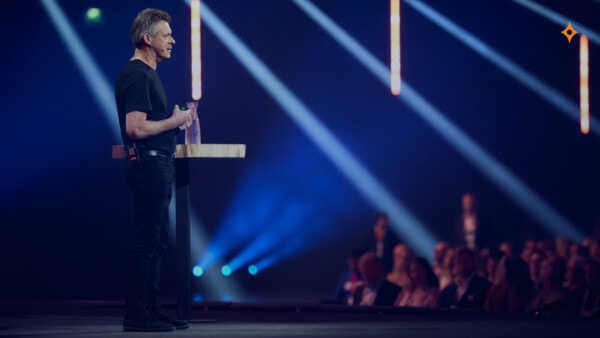12Oct2023
Sheena Iyengar, Professor of Business at Columbia Business School, respected researcher, and author of the best-selling books The Art of Choosing and Think Bigger introduced herself with two remarks. First, she would talk about “how we can think bigger” and create meaningful choices to solve complex problems. Second, being blind and unable to see the audience’s reactions, she needed people to speak up and call out the answers to the questions she would ask during her presentation.
The Power of Combining
Without further ado, the Statue of Liberty images flashed on the mainstage screens and Sheena posed the question: “Where did this idea come from?” She said that the widely known story of how Frédéric Auguste Bartholdi built Lady Liberty in France and shipped it to the U.S. follows the hero’s journey. The French sculptor had a vision and pursued his dream against all odds. But this journey does not account for the origin of the idea. To trace it, Sheena proposed another story that disclosed the main artistic influences in the sculptor’s career and how they impacted on his celebrated creation.
From his early childhood Bartholdi was immersed in art and as a young man he was part of a group of people that was sent to Egypt, where he was captivated by the colossal statues guarding the tombs. Later on, while he was building Lady Liberty, Jules Lefebrev’s painting La Vérité, or The Lady of Truth, was exhibited at the Musée d’Orsay; in that painting a woman holds a torch in an identical pose to Lady Liberty. But Bartholdi created Lady Liberty, not Lady of Truth. Sheena added that the French were enamored by the Roman goddess Libertas and, as a matter of fact, that figure was minted on the five-franc coins of the nineteenth century. Finally, a photograph revealed the statue’s face closely resembled Bartholdi’s mother.
Sheena placed the images of giant Egyptian sculptures, La Vérité painting, Libertas goddess, and the face of Bartholdi’s mother alongside on the same slide, revealing that Bartholdi had taken different features from each image, pieces that were familiar and appealing to him and combined them to create the statue.
According to Sheena, “all innovation is a new combination of existing elements.” Yet we think that there is something special about Bartholdi’s masterpiece because in great innovations the whole is greater than the mere sum of the parts.
How to Innovate
Sheena explained that the Think Bigger method “unpacks how we create those special combinations, how we use research, analysis, experience, and judgment to create unique pieces.”
In order to walk the audience through this way of thinking, Sheena gave another example of how an innovator came up with a novel idea: the inventor Nancy Johnson had a brilliant idea that dates back to the 1800s, and that idea is “the ice cream-maker.”
At that time, the process of making ice cream was extremely strenuous. People used a big bowl filled with ice and a smaller bowl of milk inside it. They stirred the milk continuously to prevent the formation of lumps, a task that got harder as milk began to freeze. “So, here’s the problem she was trying to solve: How do we simplify the making of ice cream? What are the challenges? How do I keep it cold? How do I make the stirring process easier? How do I prevent the formation of lumps?”
Next, Sheena revealed how Nancy Johnson approached each of those questions. To keep milk cold, she took pewter mugs, a vessel men had used for over 400 years to keep beer cold in taverns. To make stirring less arduous she took a hand grinder that was already being used for grinding coffee and spices and attached the spatulas to it. Finally, she made holes in the spatulas so that the liquid could run through and, thus, lumps would not form.
“Innovation is a useful, novel combination of existing ideas that come together to solve a complex problem,” synthesized Sheena. In addition, the four steps to make it happen are the following:
- Define the problem
- Break down the problem into its three to five most important sub-problems or sub-parts
- Search for ways in which you can solve each of those parts
- Imagine how to combine and recombine the partial solutions until you get to solve the problem
The Choice Map
After laying out the four steps of the Think Bigger method, Sheena offered some clues about how “to supercharge the brain” to have flashes of ideas. “The mind is like a giant inventory system, like an Excel spreadsheet,” she explained. We collect and store information bits onto shelves across our mind, and every time we hear a question, the information is pulled out.
To think out of the box, Sheena said that we need to connect pieces of information, and discover how they can be rearranged into what she called a “choice map”. A choice map is like a table on which each row is one of the sub-parts of the problem, and columns reflect possible solutions or tactics for the sub-parts. Some of these solutions are in the domain of the problem, but some of the tactics are brought to the table from other domains.
“You define the problem, you break it down, and for each sub-problem, you go out into the world and search for different ways in which that problem has already been solved,” Sheena summed up. Then you combine the different options to get all the different possibilities. Choosing the adequate ones from all these multiple potential solutions is key to innovating. “To invent is to choose,” commented Sheena towards the end of her keynote. And inversely, “to choose is to invent.”

Visual summary of Sheena Iyengar’s keynote by Linda Saukko-Rauta
Want to get the full summary of the Nordic Business Forum 2023 speeches + extra content for reflecting on your learning? Download your free copy of the full Executive Summary and summaries from previous events!


